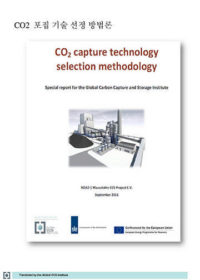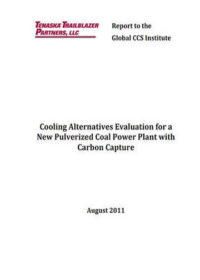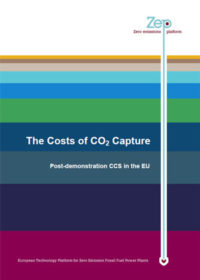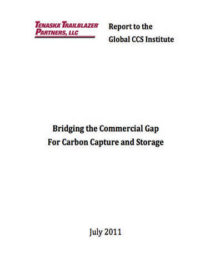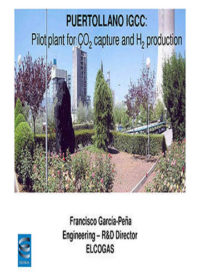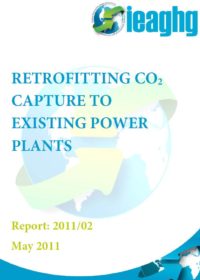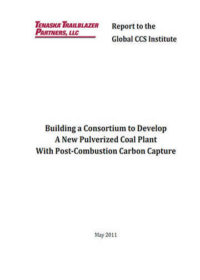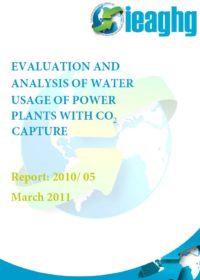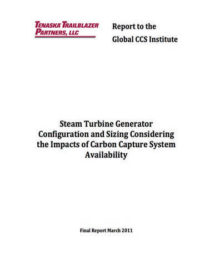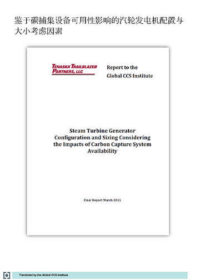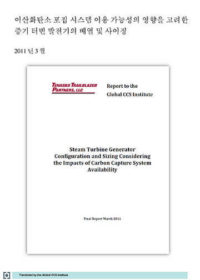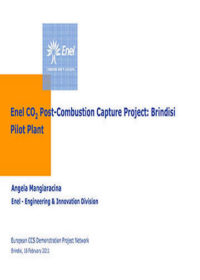Resources
Publications
Our publications, reports and research library hosts over 500 specialist reports and research papers on all topics associated with CCS.
View our Publication Library Disclaimer.
Filter by
Disclaimer
The content within the Global CCS Institute Publications, Reports and Research Library is provided for information purposes only. We make every effort and take reasonable care to keep the content of this section up-to-date and error-free. However, we make no claim as to its accuracy, currency or reliability.
Content and material featured within this section of our website includes reports and research published by third parties. The content and material may include opinions and recommendations of third parties that do not reflect those held by the Global CCS Institute.
Cooling alternatives evaluation for a new pulverized coal power plant with carbon capture
1st August 2011
Topic(s): Carbon capture use and storage (CCUS), CO2 capture
The Tenaska Trailblazer Energy Center is expected to be the first new-build coal plant in the United States to incorporate a commercial-scale carbon dioxide capture plant into the initial design. The project is designed to capture 85 to 90 per cent of the CO2 that otherwise would be emitted into the atmosphere.
The CO2 captured from the project will be sold into the Permian Basin CO2 market in West Texas, where it will be used in Enhanced Oil Recovery (EOR) and ultimately stored permanently underground. The Trailblazer project will consist of both a state-of-the-art pulverized coal facility (PC Plant) and a carbon capture facility (CC Plant).
The project is located in a semi-arid area, with annual rainfall averaging about 22 inches (56 centimeters). As such, very early in the project’s development Tenaska explored several cooling options, including air cooling, full wet cooling and partial wet cooling (hybrid cooling). Through this high-level analysis and due to water rights restrictions -- and for other strategic reasons -- Tenaska assumed that Trailblazer would need to employ air cooling in order to reduce the PC Plant’s water usage. This report describes the process used to determine the best alternative for the project’s cooling systems.
Disclaimer
The content within the Global CCS Institute Publications, Reports and Research Library is provided for information purposes only. We make every effort and take reasonable care to keep the content of this section up-to-date and error-free. However, we make no claim as to its accuracy, currency or reliability.
Content and material featured within this section of our website includes reports and research published by third parties. The content and material may include opinions and recommendations of third parties that do not reflect those held by the Global CCS Institute.
The costs of CO2 capture: post-demonstration CCS in the EU
15th July 2011
Topic(s): Carbon capture use and storage (CCUS), CO2 capture, Economics
The companies, scientists, academics and environmental NGOs that together make up the Zero Emissions Platform (ZEP) have undertaken a ground-breaking study into the costs of CO2 capture based on new data provided exclusively by ZEP member organisations on existing pilot and planned demonstration projects. This report describe costs associated with the capture process and the conditioning and compression/liquefaction of the captured CO2 required for transport. The technologies studied are first-generation capture technologies, namely post-combustion CO2 capture, IGCC with pre-combustion capture and oxy-fuel for hard coal, lignite and natural gas.
Disclaimer
The content within the Global CCS Institute Publications, Reports and Research Library is provided for information purposes only. We make every effort and take reasonable care to keep the content of this section up-to-date and error-free. However, we make no claim as to its accuracy, currency or reliability.
Content and material featured within this section of our website includes reports and research published by third parties. The content and material may include opinions and recommendations of third parties that do not reflect those held by the Global CCS Institute.
Bridging the commercial gap for carbon capture and storage
1st July 2011
Topic(s): Carbon capture use and storage (CCUS), CO2 capture, Project financing
Tenaska share their analysis of the commercial market factors which drive their project. This project plans to sell electricity into the Electricity Reliability Council of Texas (ERCOT) energy market, capture over five million tonnes of CO2 per year, and sell it into the Permian Basin Enhanced Oil Recovery (EOR) market both of which have large unmet demand. This report discusses the economic realities facing the Trailblazer Project to incorporate a commercial-scale carbon dioxide capture plant into its initial design. It reviews the markets for both electricity and carbon dioxide, and discusses the governmental support that may be needed to bridge the gap between the Project’s likely costs and revenues.
Disclaimer
The content within the Global CCS Institute Publications, Reports and Research Library is provided for information purposes only. We make every effort and take reasonable care to keep the content of this section up-to-date and error-free. However, we make no claim as to its accuracy, currency or reliability.
Content and material featured within this section of our website includes reports and research published by third parties. The content and material may include opinions and recommendations of third parties that do not reflect those held by the Global CCS Institute.
Puertollano IGCC: Pilot plant for CO2 capture and H2 production
9th June 2011
Topic(s): CO2 capture, CO2 utilisation
Disclaimer
The content within the Global CCS Institute Publications, Reports and Research Library is provided for information purposes only. We make every effort and take reasonable care to keep the content of this section up-to-date and error-free. However, we make no claim as to its accuracy, currency or reliability.
Content and material featured within this section of our website includes reports and research published by third parties. The content and material may include opinions and recommendations of third parties that do not reflect those held by the Global CCS Institute.
Retrofitting CO2 capture to existing power plants
23rd May 2011
Topic(s): Carbon capture use and storage (CCUS), CO2 capture
This study assesses at a generic level the relative merits of retrofitting CCS to existing power plants and building new plants with CCS. As such it focuses mainly on the question "is CCS retrofit worth doing" rather than "can it be done". The latter would need to be addressed by detailed site specific studies for individual plants, examples of which are being undertaken by other organisations. However, the study also reports on high-level assessments of the potential for CCS retrofits in various countries: the USA, UK and China.
Disclaimer
The content within the Global CCS Institute Publications, Reports and Research Library is provided for information purposes only. We make every effort and take reasonable care to keep the content of this section up-to-date and error-free. However, we make no claim as to its accuracy, currency or reliability.
Content and material featured within this section of our website includes reports and research published by third parties. The content and material may include opinions and recommendations of third parties that do not reflect those held by the Global CCS Institute.
Building a consortium to develop a new pulverized coal plant with post-combustion carbon capture
1st May 2011
Topic(s): Carbon capture use and storage (CCUS), CO2 capture, Engineering and project delivery
The development of a complex project such as the Trailblazer project requires the selection, relationship management and coordination of a diverse consortium, including: developers, equity partners, engineering, procurement and construction contractors, operations and maintenance contractors, fuel suppliers, fuel transporters, water suppliers, power purchaser, carbon dioxide purchaser, Local, State and Federal Governments and lenders. The report discusses the factors considered in Tenaska’s approach to building and managing the consortium required to develop, construct and operate the project.
Disclaimer
The content within the Global CCS Institute Publications, Reports and Research Library is provided for information purposes only. We make every effort and take reasonable care to keep the content of this section up-to-date and error-free. However, we make no claim as to its accuracy, currency or reliability.
Content and material featured within this section of our website includes reports and research published by third parties. The content and material may include opinions and recommendations of third parties that do not reflect those held by the Global CCS Institute.
Evaluation and analysis of water usage of power plants with CO2 capture
22nd March 2011
Topic(s): Carbon capture use and storage (CCUS), CO2 capture, Health safety and environment
The primary purpose of this study is a review of the current state of the art technology in reducing water consumption for any coal or gas fired power generation technologies.
Disclaimer
The content within the Global CCS Institute Publications, Reports and Research Library is provided for information purposes only. We make every effort and take reasonable care to keep the content of this section up-to-date and error-free. However, we make no claim as to its accuracy, currency or reliability.
Content and material featured within this section of our website includes reports and research published by third parties. The content and material may include opinions and recommendations of third parties that do not reflect those held by the Global CCS Institute.
Steam turbine generator configuration and sizing considering the impacts of carbon capture system availability
1st March 2011
Topic(s): Carbon capture use and storage (CCUS), CO2 capture
The steam turbine configuration and sizing is a critical part of the design basis for the coal fired power plant, and in particular with plans for incorporating carbon capture and storage. This report, undertaken by Tenaska as part of its plant design work for the Trailblazer project, examined plant operating modes, part load operation, overall operability and ultimately the profitability of the plant given the markets for power and CO2 in Texas. Since the carbon capture process utilises approximately 30 per cent of the steam energy generated in the boiler, the key question addressed is should the steam turbine be sized for 70 per cent flow left when the carbon capture plant is running, or the full steam flow to generate more power when the carbon capture plant is off-line.
Tenaska worked with a number of major steam turbine generator (STG) manufacturers to develop steam/water cycles for the Project that would allow either the simultaneous generation of power and provision of steam for the flue gas carbon capture process, or operation power generation only mode with no steam to the carbon capture process. Project developers and technical staff may benefit from the lessons learnt from the Trailblazer project in this study.
Disclaimer
The content within the Global CCS Institute Publications, Reports and Research Library is provided for information purposes only. We make every effort and take reasonable care to keep the content of this section up-to-date and error-free. However, we make no claim as to its accuracy, currency or reliability.
Content and material featured within this section of our website includes reports and research published by third parties. The content and material may include opinions and recommendations of third parties that do not reflect those held by the Global CCS Institute.
鉴于碳捕集设备可用性影响的汽轮发电机配置与大小考虑因素
1st March 2011
Topic(s): Carbon capture use and storage (CCUS), CO2 capture
该项目是一个位于美国德克斯州诺兰县正处于设计时期的超临界粉煤发电厂,大约离德克斯州斯威特沃特九英里远。发电厂在碳捕集关闭下(CC OFF)的运营模式下的额定功率可达760百万瓦特。
Disclaimer
The content within the Global CCS Institute Publications, Reports and Research Library is provided for information purposes only. We make every effort and take reasonable care to keep the content of this section up-to-date and error-free. However, we make no claim as to its accuracy, currency or reliability.
Content and material featured within this section of our website includes reports and research published by third parties. The content and material may include opinions and recommendations of third parties that do not reflect those held by the Global CCS Institute.
이산화탄소 포집 시스템 이용 가능성의 영향을 고려한 증기 터빈 발전기의 배열 및 사이징
1st March 2011
Topic(s): Carbon capture use and storage (CCUS), CO2 capture
Disclaimer
The content within the Global CCS Institute Publications, Reports and Research Library is provided for information purposes only. We make every effort and take reasonable care to keep the content of this section up-to-date and error-free. However, we make no claim as to its accuracy, currency or reliability.
Content and material featured within this section of our website includes reports and research published by third parties. The content and material may include opinions and recommendations of third parties that do not reflect those held by the Global CCS Institute.
Enel CO2 post-combustion capture project: Brindisi pilot plant
16th February 2011
Topic(s): CO2 capture
Disclaimer
The content within the Global CCS Institute Publications, Reports and Research Library is provided for information purposes only. We make every effort and take reasonable care to keep the content of this section up-to-date and error-free. However, we make no claim as to its accuracy, currency or reliability.
Content and material featured within this section of our website includes reports and research published by third parties. The content and material may include opinions and recommendations of third parties that do not reflect those held by the Global CCS Institute.
